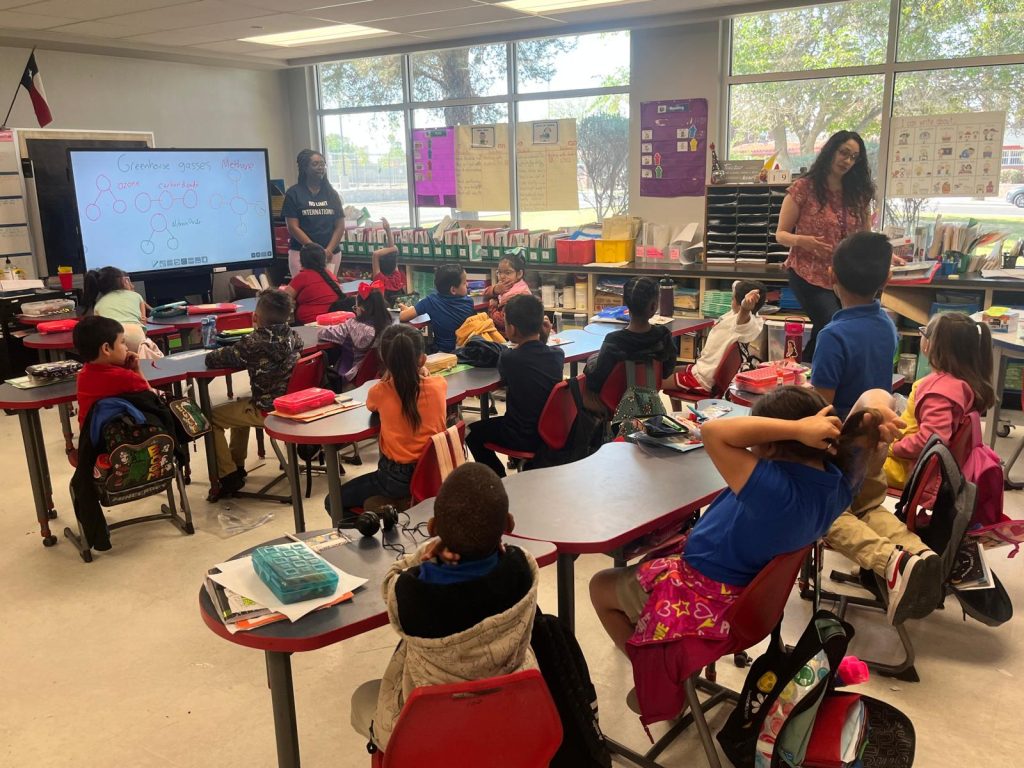There’s nothing like connecting with young minds about our planet! My reading sessions have been one of the most exciting parts of my journey. Seeing kids get curious and excited about wildlife conservation is both incredibly rewarding and affirming. It has been of the utmost importance to me to connect with these students and share with them the world of environmental activism. So, here’s a behind-the-scenes look at how I bring The Wildlife Warriors: Saving Their Habitats to life in classrooms with 1st and 2nd graders.
Prep Time: Gearing up for the Session
To the session, I bring a copy of my book, The Wildlife Warriors: Saving Their Habitats, supplies for the greenhouse gas activity, and biodegradable bookmarks! Running through the book ahead of time is key—I practice character voices and gestures, and I brainstorm questions I’ll ask to keep them thinking. All this preparation helps to ensure a smooth sailing impactful session. Additionally, I go over the activity, making sure I know all about greenhouse gases and am prepared for any questions.
Arriving at the School: The First Spark
Stepping into the school, I see little faces lighting up with curiosity and excitement. After a warm hello, I introduce myself as an author and a high school student and share why I wrote this book. Walking into the reading session, it’s so nice to see the children’s excitement, the teachers’ welcoming smiles, the setup of the room, and the eager faces waiting to hear your story. I ask them questions about the environment such as “What’s Earth Day?” or “What’s one way to help the environment?” With questions like these, I get to gauge their preexisting knowledge of the environment
Story Time
Reading is my favorite part! With each character’s voice and some sound effects (like when Paisley the Polar Bear falls through cracking ice), I keep the kids on their toes, letting them predict what might happen next. The students are always so encaptured and engaged by the story. After reading the book, I ask the students a couple of questions like, “What were the four environmental issues that were going on in the animals’ habitats?”, “What was the message the animals wanted to get across to you guys?”, or “What was one way the animals said you could help them?” This way, I review the book to see if they understood the deeper meaning and importance of environmental activism. This recap helps to reinforce the theme of standing together in the fight against climate change.

Q&A with the kids
After storytime, I flip things around and let the kids ask me questions. With their insights about the book, the session becomes a two-way learning street. I learn about what resonates with them and what I can carry into future projects. They love to ask anything from “What inspired the book?” to “How do you become an author?” By answering these questions, I share more of my story with them. I encourage them to forge their path and see the power of writing. Even though they are first and second-graders, it doesn’t stop them from pursuing their dreams and writing a book like me.
Activity
Now, it’s time for our greenhouse gas activity! On the whiteboard, I draw models of the greenhouse gases methane, carbon dioxide, nitrous oxide, and ozone. While drawing the models, I explain what greenhouse gases are, where each specific gas is produced, and ways we can reduce the emissions. The students always love this mini-lesson and are especially excited when they get to make their own model. They each choose a gas and create mini models using biodegradable lollipop sticks and gummies. They’re thrilled to explain their creations to the class and share ways to reduce emissions. This activity helps the students successfully apply what they learned in a fun and tasty way.

Wrapping Up: Leaving a Little Magic Behind
As we finish up, I hand out high-fives and biodegradable bookmarks as the kids file out. After that, I also dedicate the book to the school library, leaving a little message to inspire all who read to stand up for what they believe in. Moments like when a little girl hugged me and said, “I want to be like you when I grow up!” are priceless—they remind me why I started this journey. Each reading session not only fuels my passion for educating young minds about the environment but also strengthens my resolve to create a more eco-conscious world. I hope that each session lights a spark in them to become wildlife warriors!





